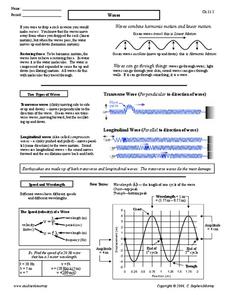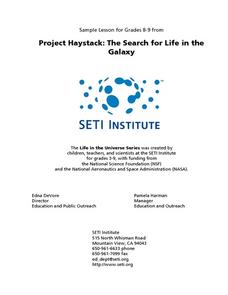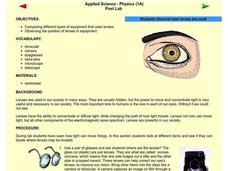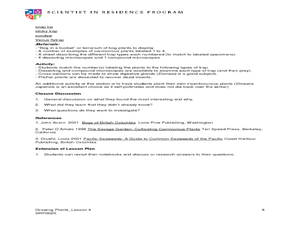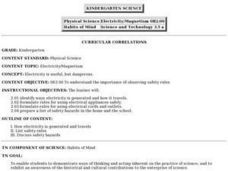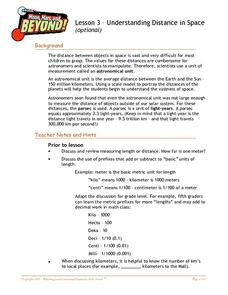Curated OER
Why Do We Have Night?
Young scholars engage in a fun, creative way to discover how the Earth moves. This lesson helps students explain why there is day and night. It can also create curiosity to further study the solar system and eclipses!
Curated OER
MAPPING THE TOPOGRAPHY OF UNKNOWN SURFACES
Students describe in words and graphic displays the elevation or depression profile of sections of Mars' Olympus Mons and/or Valles Marineris. They explain how orbiting spacecraft build up global maps one data slice at a time.
Curated OER
Waves
In this waves worksheet, students read about the different types of waves and how the speed of waves is calculated. Then students complete 5 matching, 8 fill in the blank, and 9 short answer questions.
Curated OER
Plant and Animal Changes
Second graders listen as the book, "What Do Animals Do In Winter?" is read to the class. They discuss that during the winter, some animals migrate, hibernate, hide, change color, and some make changes in their bodies like growing extra...
Curated OER
Electron Microscope
In this microscope worksheet, students use an on line site to answer questions about how a Scanning Electron Microscope works. They also conduct a virtual microscope activity where they view ten specimens and identify what each is.
Curated OER
Information, Please!
Students examine how aluminum is recycled. In this recycling lesson, students participate in a field trip to a local recycling center to observe the process of recycling aluminum. Students take notes and report their findings.
Curated OER
Mission 3: Electrical Safety
In these recognizing electrical safety in the kitchen, bathroom, living room, outdoors, and in a storm worksheets, students read for information, identify electrical appliances, types of light switches, list possible dangers for each...
Curated OER
Water and Ice
Students explore water. In this water lesson plan, students explore the physical properties and states of water. They observe how water changes states and document what they see.
Curated OER
How Long Would It Take To Travel To the Stars?
Students consider the amount of time that it would take to get to the star, Sirius using various modes of transportation, some practical and some whimsical. The practicality of physically going to another star system is explored in this...
Curated OER
Frozen Film
Students are introduced to the topic of light interference through this hands-on activity. They observe how light reflects off two surfaces and then meets to form an interesting variation of color on a film surface.
Curated OER
Speed of Sound
Students examine the phenomenon of sounds traveling slower than light. They discover why they see things before they hear them and how to estimate the speed of sound as homework.
Curated OER
Lenses
Students explore vision by experimenting with lenses in equipment. For this optics lesson, students define the different technology that enhances vision such as microscopes, telescopes and cameras. Students experiment with these devices...
Curated OER
Hello, Sunshine!
Students investigate how the sun travels across the sky at different latitudes using Solar Motion Demonstrator. In this earth science lesson, students explain why seasons change. They study how the tilt of the Earth's axis affects...
Curated OER
Seasonal CEENBoT
Students simulate the Earth's revolution around the sun using CEENBoT. In this earth science instructional activity students calculate the Earth's distance in AU and it's speed of revolution. They explain how the Earth's movement cause...
Big Kid Science
Create a Milk Carton Camera to Observe the Eclipse!
Step aside, fancy glasses... it's time to create a solar eclipse viewing camera of your own using nothing more than a milk carton.
Curated OER
Electric Current
In this electric current activity, students review vocabulary words associated with electricity. Students understand how electricity is used in their lives every day. This activity has 12 fill in the blank questions.
Curated OER
Microscopy Exercises
Students explore organisms and botany by utilizing microscopes. In this microscopic research lesson, students define many plant and organism related vocabulary terms such as conifers, moss and spores. Students view spores and other...
Curated OER
All Those Seeing Color, Say Eye!
Students discuss feelings and explore how to recognize how they are feeling. In this exploratory instructional activity students discuss conflict and ways to resolve problems.
Curated OER
Factor Conversion
In this factor worksheet, learners practice doing factor conversions of time, length, speed, and weight. This worksheet has 12 word problems to solve.
Curated OER
Color Combinations
Students develop a basic understanding of how color is perceived by the eye. They utilize the technique Seurat used to paint A Sunday on La Grande Jatte to create their own paintings.
Curated OER
Quiz: Astronomy
In this science worksheet, 3rd graders will focus on various aspects of astronomy. Students will respond to ten questions all pertaining to stars, constellations, planets, and our solar system.
Curated OER
What Really Matters When it Comes to Sound?
Learners conduct experiments to learn about sound wave vibrations in objects and pitch. Students test how varying the volume of water in a vessel changes frequency and pitch.
Curated OER
Electricity Danger
Pupils determine how electricity is useful but also can be dangerous. They observe a teacher demonstration of the hazards associated with touching wires using a puppet, batteries, wire, and a light bulb. They devise a list of electricity...
Curated OER
Understanding Distance in Space
Students discover the vocabulary used for distances in space and review measurement units and instruments before creating a scale model of the planets. They determine how to calculate the relative distances between the planets using a...




